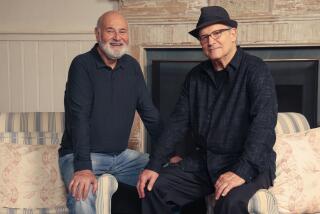Return of a Rebel : Robert Altman Is Back in Hollywood . . . but Not of It
Those who expected director Robert Altman to go mainstream after his success with the anti-Hollywood spoof “The Player” are in for a surprise. Passing up high-profile, higher-budget projects, the iconoclastic veteran used his newly retrieved leverage to get “Short Cuts”--a dark, literate venture previously turned down by every major studio--off the ground.
In the $12-million movie, currently midway through the shoot, Altman interweaves eight short stories and one poem by Raymond Carver--another astute observer of the contemporary American cultural canvas. Though the director has employed a multicharacter, multiplot structure before, most notably in his 1975 “Nashville” and his Emmy Award-winning miniseries “Tanner ‘88,” this one takes it to new heights.
For the record:
12:00 a.m. Sept. 9, 1992 For the Record
Los Angeles Times Wednesday September 9, 1992 Home Edition Calendar Part F Page 2 Column 4 Entertainment Desk 1 inches; 27 words Type of Material: Correction
Lewis Role-- Rocker Huey Lewis made his first film appearance in “Back to the Future.” Last Wednesday’s Calendar incorrectly reported that “Short Cuts” would mark his first film appearance.
“The film is an experiment,” says the 67-year-old director of the project, scheduled for release by Fine Line Features and Spelling International next summer. “Though television shows such as ‘L.A. Law’ and ‘Hill Street Blues’ have been using concurrent stories for years, this movie is a new approach to film art.”
Cast in the 22 major speaking parts are some actors featured in “The Player”--Tim Robbins, Peter Gallagher, Lyle Lovett and Fred Ward--and a talent lineup which, like its predecessor’s, reads like a Who’s Who in Hollywood: Anne Archer, Bruce Davison, Robert Downey Jr., Buck Henry, Jennifer Jason Leigh, Jack Lemmon, Huey Lewis, Andie MacDowell, Frances McDormand, Matthew Modine, Julianne Moore, Christopher Penn, Annie Ross, Lori Singer, Madeleine Stowe, Lili Taylor, Lily Tomlin and Tom Waits. Because each is working for the same fee, well below his or her asking price, no one will be required to work more than 10 days.
Instead of shooting in Carver’s native Northwest, Altman opted to shoot in Los Angeles. Not in the rarefied circles in which his “Players” hung out, but in Hawthorne, Downey and La Puente--where Gallagher’s Medfly helicopter pilot, Lovett’s baker and Robbins’ LAPD cop seek their version of the American dream.
“It’s like filming nine different movies back to back one week at a time,” says producer Cary Brokaw. “Actors are coming and going. You have to discover their individual rhythms and develop rapport. The scheduling has been intricate, to put it mildly. It’s an ongoing jigsaw puzzle, a logistical nightmare.”
To keep track of the action, Altman and co-writer Frank Barhydt, with whom he collaborated on “Quintet” (1979), “Health” (1980) and “Tanner,” relied on a 20-foot-long bulletin board. On it were posted 145 3x5-inch index cards, color-coded not only by character but by the time of day that the action takes place. Altman admits to being overwhelmed nevertheless. “I wasn’t quite prepared,” he says. “Usually, actors struggle to find out who they are and where they are going during the first few weeks. Things settle down during weeks five through seven--which is when they’re leaving this time around.”
*
The director discovered Carver when he was flying back from Italy in February, 1990--following the completion of “Vincent and Theo” and his ejection from the set of “Rossini, Rossini” after locking horns with the film’s Italian producer. “I felt very much in tune with Carver,” the director says. “He writes about the inside . . . not the outside.”
The two, observe Altman’s colleagues, are kindred spirits. Carver, a recovering alcoholic who died in 1988, didn’t find happiness and professional success until later in life. His stories zero in on the everyday struggles and moral dilemmas of ordinary folk. In one of the stories depicted in the film, he shows the impact of giving up a dog on a family in crisis. In another, the ripples created in their lives when three fishermen discover a body in a river.
Altman, a freewheeling, egalitarian sort, also battled his addictions. Though he scored early with TV shows such as “Alfred Hitchcock Presents” and “Combat” and films such as “MASH” and “Brewster McCloud,” the director also bottomed out. After a series of box-office disappointments and the critical skewering of the $27-million “Popeye,” Altman sold his company, Lion’s Gate, and distanced himself from Hollywood. The next decade was spent directing stage adaptations, low-budget movies and TV dramas.
“Bob had a tough time in the ‘80s,” observes Barhydt. “But I never sensed that he was feeling sorry for himself. Like Carver’s characters, he just kept going. Though not every film he makes will be up to his standards, that’s not what matters in the end. Bob take joy in everything. He’s one of the best examples of ‘hanging in there’ I know.”
Altman, for his part, resists any easy parallels. Similarities between him and Carver, he says, are in the eyes of the beholder. “I’m not aware of the bumps as much as others, I suppose,” he says with a laugh. “I feel like I’ve gotten a great shake.”
Barhydt and Altman wrote a first draft of “Short Cuts,” completing it in July, 1990. Though poet Tess Gallagher, Carver’s widow, gave them her blessing, Paramount Pictures, who had advanced them the development money, had its doubts. When David Kirkpatrick, the studio’s then head of production, arrived from Disney, he re-evaluated the project and put it in turnaround--up for grabs to anyone willing to reimburse the studio for its investment.
No one did. “It was a period of raised hopes and dashed hopes,” recalls Barhydt. “We just couldn’t get the money together because the project wasn’t considered sufficiently funny or hopeful. At one point, I was looking for a window from which to jump. Now, of course, we’re involved in a ‘hot project.’ It’s more than a little ironic.”
*
The 1992 Cannes Film Festival and “The Player’s” enthusiastic reception turned things around. Though Brokaw, executive producer of “The Player,” had reservations of his own, he ultimately threw his weight behind “Short Cuts.” “Bob convinced me that the film had warm and positive human attributes,” recalls the executive, who, away from the set, serves as chairman of Avenue Pictures, “and agreed to soften the bleakness and touches of misogyny. In dailies now, the film is anything but--more real, vivid, and funny than on the page. Bob lets the characters have a life of their own. He doesn’t resist deviations.”
That a deal for “Short Cuts” was signed 26 hours after “The Player” was first screened at Cannes--in a very competitive bidding environment--came as no shock to Altman. “Same script, same director,” he points out. “Then, after a year-and-a-half of bad news, ‘The Player’ generated a little heat around it and everything changed overnight.
“Fortunately, this is the third or fourth time I’ve been in this spot, so I’m pretty practiced in my despair. I understand the system very well.”
Once the project was a reality, Altman was besieged with calls from A-list actors wanting to take part. Instead, he remained loyal to those actors who’d committed years before. Many of them were ICM clients, since the director was signed with the agency at the time. (He has subsequently departed for the rival William Morris.)
Many of them are also musicians: Huey Lewis in his first film role, as well as Waits and Lovett. Altman, a great lover of music, has arranged for “Saturday Night Live’s” music coordinator Hal Wilner to produce the soundtrack. Though still in the planning stage, it is expected to contain two original songs each from both Dr. John and Elvis Costello, as well as another tune written for Marianne Faithfull by U2’s Bono and Edge. Lori Singer, an accomplished cellist, will play with a classical ensemble. Annie Ross, whose character owns a jazz club in the movie, will sing.
Brokaw may take the movie to Cannes--especially in light of last year’s success. “The Player” which has taken in nearly $21 million domestically and is due out on video in April, may also get a new lease on life. If the film, as expected, surfaces on a lot of 10-Best lists and snags some critics’ awards, a broader re-release--in some 600 theaters--is planned for year’s end.
“ ‘The Player’ was Altman’s comeback movie,” Brokaw says, “but ‘Short Cuts’ reveals a great filmmaker hitting his stride. It’s much more ambitious commercially and artistically. Bob is a lot less angry these days, with good reason. You can see it on the set. Still he hasn’t changed his mind about politics or the industry. Robert Altman will never be defanged.”
More to Read
Only good movies
Get the Indie Focus newsletter, Mark Olsen's weekly guide to the world of cinema.
You may occasionally receive promotional content from the Los Angeles Times.










